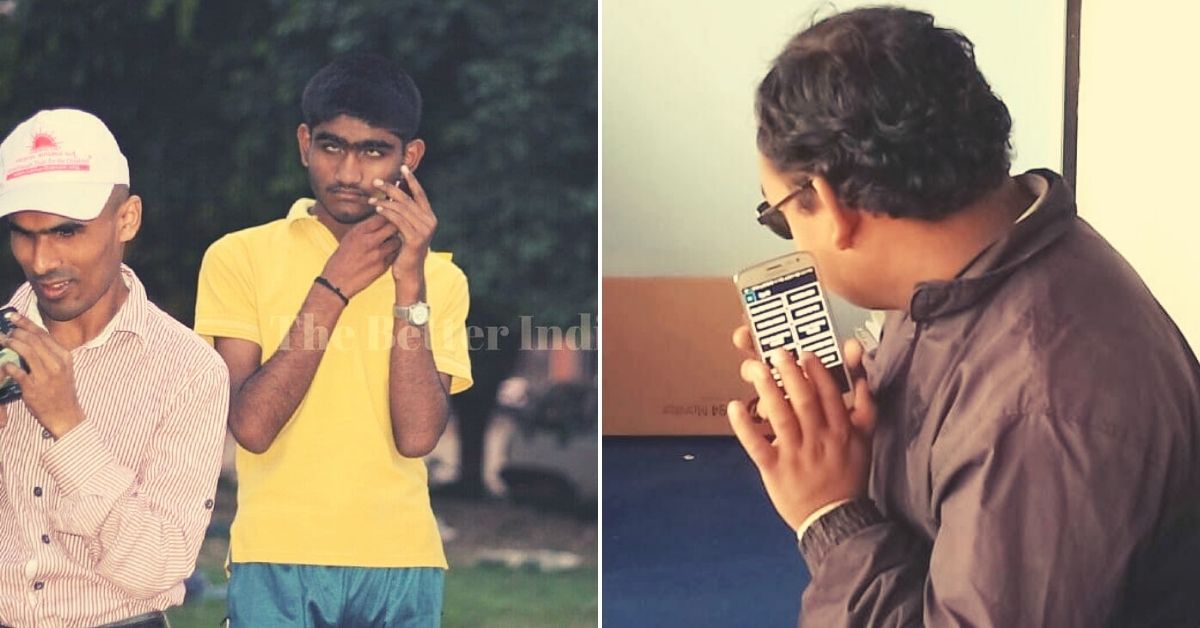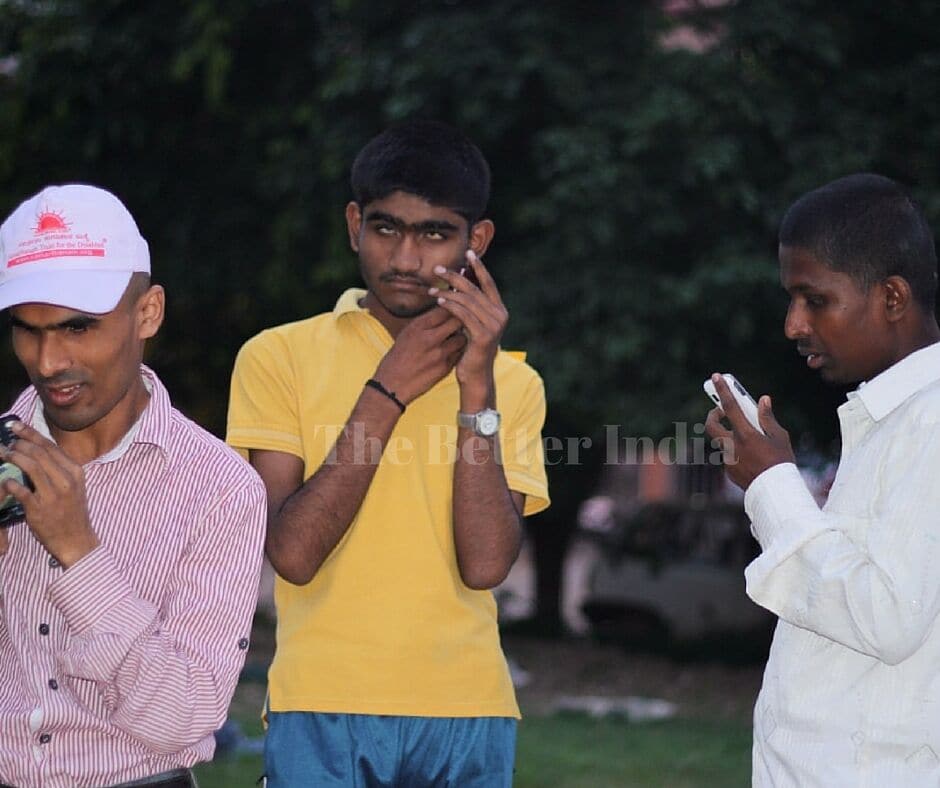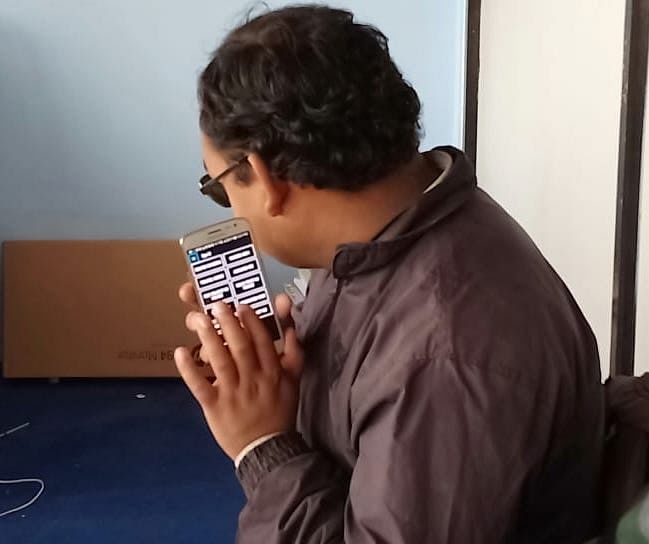COVID-19 Is So Much Harder for the Visually Impaired. Here’s How We Can Help
"Everything is closed here. I haven't moved outside my home for the past five months as my family warned me to not do that, since our lives depend on touching surfaces."

Even as visually impaired people are navigating the COVID-19 pandemic right alongside their sighted friends and family members, they face some unique challenges of their own.
“Everything is closed here. I haven’t stepped outside my home for the past five months — my family warned me to not do that, since our lives depend on touching surfaces. However, at home, I don’t have any facilities to keep my game going. It’s been a very tough time,” says Sunil Ramesh Kumar, the captain of the Indian National Blind Cricket Team, who lives in Chikkamagaluru, Karnataka.
Fortunately, his family has stepped up their efforts to ease his difficulties.
“My family has been helping me in all my daily operations. Financially, the cricket board is supporting me by paying monthly remuneration (Rs 5,000-8,000), although it’s not like before. These days cash flow is very limited. I know people with physical disabilities like mine have suffered more than most during the pandemic, but I would request every visually challenged person to stay at home and not to move outside. What choice do we have! I only pray for better days,” he says.
For Rigzin Dolma, who has been visually impaired since her childhood following an accident, it’s the inability to escape the confines of her home in Leh that has proven to be a challenge.
“Listening to the news or radio, the constant instruction people are given is to avoid touching foreign surfaces. However, since I lost my eyesight, touching surfaces has helped me navigate my way in this world. Since the first lockdown I have been confined to my home, although my parents allow me to step out into our garden and walk within the compound of our house. But I miss spending time with my friends and cousins, and I hope these dark times come to an end soon,” she says, speaking to The Better India.
While Sunil and Rigzin can count on the support of their families, there are some who are living alone and it’s hard to imagine how they are getting by.
Speaking to The New Indian Express, 42-year-old P Raja, who has been living alone in Egmore, Chennai, since his wife and daughter left for Madurai just days before the lockdown, recounted his struggles. “Volunteers come and drop the materials and leave. I have not even spoken to anyone properly since my phone too is under repair. Once public transport begins, it will be even more difficult if nobody helps us. We cannot stay at our homes since we do not know when the pandemic will end,” he said, speaking to the publication.
Mahantesh GK, founder of the Bengaluru-based Samarthanam Trust for the Disabled, concurs.
“For visually impaired persons living alone, it has been extremely challenging. They have to do everything on their own — cooking, cleaning, washing utensils, getting provisions and taking care of the house they live in because nobody comes to take care of them. Many apartments don’t allow servants to enter the premises to assist them. You can’t imagine their plight. It has been a nightmare. Many of them break down into tears, while some have burnt their hands trying to cook. This has taken a serious toll on their mental health. Many of them have become depressive considering their blindness and loneliness,” he says.
Meanwhile, Rahul Deshmukh, the founder of the National Association For The Welfare Of Physically Challenged in Pune, speaks about how, for blind and visually impaired students from low income communities, the pandemic and subsequent lockdown have affected their studies.
“Students are ready to learn and they have requested the management to start online classes. But the issue is that most of them are from villages and remote areas, and are unable to connect to the classes due to the unavailability of smartphones and bad networks. They are still trying different measures like talking to them over the phone on a regular basis to maintain their interest levels.”

Helping the Visually Challenged
Samarthanam Trust has been ensuring that these persons have the bare necessities.
“Following the lockdown, we started getting a lot of calls from our visually impaired friends across the country needing all sorts of assistance. We distributed dry ration kits to many in the disabled community and their families, but particularly those who are visually impaired across different age groups. 50% of dry rations went to visually challenged persons and their families. All these rations arrived at their doorstep across India, but mostly in Bengaluru and Delhi and small district towns like Belgaum and Dharwad. At least 4,000 visually impaired people and their families received dry rations from us across India on a one time basis,” says Mahantesh.
Employees of the non-profit were even directed to take care of their daily tasks like going to the bank, buying medicines for other ailments like high blood pressure and in some cases they even helped them travel to their native place after taking necessary permissions.
“We distributed one-time cash grants to more than 1,000 visually impaired persons, directly crediting that sum into their account. Visually impaired persons living in cities like Bengaluru and Delhi received Rs 7,000, while those in rural areas received Rs 5,000,” he adds.
However, obtaining the necessary funding has also been a difficult task considering the massive economic slowdown as a result of the pandemic.
“We are always up and ready to support each and every individual. We have requested all the donors to be little active during this period. Students have also created Whatsapp Groups to receive the funds. However, they are suffering a serious cash crunch. Few of the donors have told in advance that they are not in a position to help,” says Deshmukh.
What Can Governments Do?
“In spirit, governments have exempted visually impaired people from going to work or allowed them to work from home, but it should be followed very strongly on the ground. They can’t afford to step out at this time. The government must also offer strong institutional support through various Central and State funds and schemes. Many visually impaired persons have said their pensions have not been deposited yet. At this point, particularly, the government must pay extra attention and ensure all the dues are deposited into their account because visually challenged people struggle to regularly follow up. Government must also direct various housing societies to allow domestic help to assist visually challenged for their daily provisions, meals and other housework,” says Mahantesh.
Can Technology Help Visually Impaired People?
Yes, there are a myriad of mobility devices in the market for the visually challenged, but those walking sticks with tools like vibration detection and voice automation are not products everyone can afford with prices going up to Rs 5,000.
“Given the current economic situation, it is nearly impossible to buy such devices. The government must ensure that they either provide monetary support or come up with mobility devices driven by artificial intelligence. I have met at least 500 families during the lockdown to provide relief material and was shocked to find that most of them have only been sitting at their home unable to even come out for a minute. The kind of suffocation affects mental health,” said P Manoharan, member of Tamil Nadu Differently Abled Welfare Board, speaking to The New Indian Express earlier this month.

However, what technology can do in these times is help keep visually impaired persons constantly engaged with the outside world.
“Tech tools like smartphone apps can help people with blindness in a major way. A lot of modern technology is visually-impaired friendly, which is voice-enabled. They could remain better engaged with the world outside depending on their level of affordability and what device they can purchase. Ever since I was child, I would listen to All India Radio throughout the day catching up with different news stories and good music. Constant levels of engagement with the outside world helps. More importantly, they must keep active and fit doing yoga and regular breathing exercises to ensure physical and mental health is balanced so that they don’t have to go outside the house,” says Mahantesh.
What Can Visually Able Citizens Do?
To begin with, regardless of ability or disability, we can choose compassion over intolerance. For those who would like to go a step further, Deskhmukh requests that they come forward and support his students.
“Even if it’s a contribution of Rs 100 at this time, it will be of great help. My students want to reach people through the media, but are not in a position to spend anything on marketing now. However if someone can offer their services for free, it will be a great help,” he says.

“Ordinary citizens who have sight should forget the fear of touching blind people because after all most of them will not have COVID-19 since they have never stepped out. They can regularly engage them if they live nearby by asking what they need. Talk to them, read certain things to them and ask what they need. It will make a massive difference to them. They need all the love and affection in the world,” says Mahantesh.
(Edited by Gayatri Mishra)
Like this story? Or have something to share? Write to us: [email protected], or connect with us on Facebook and Twitter.
If you found our stories insightful, informative, or even just enjoyable, we invite you to consider making a voluntary payment to support the work we do at The Better India. Your contribution helps us continue producing quality content that educates, inspires, and drives positive change.
Choose one of the payment options below for your contribution-
By paying for the stories you value, you directly contribute to sustaining our efforts focused on making a difference in the world. Together, let’s ensure that impactful stories continue to be told and shared, enriching lives and communities alike.
Thank you for your support. Here are some frequently asked questions you might find helpful to know why you are contributing?


This story made me
-
97
-
121
-
89
-
167











